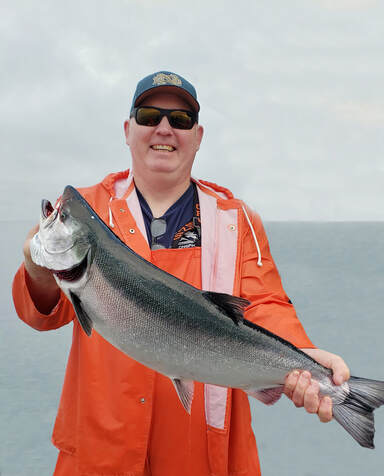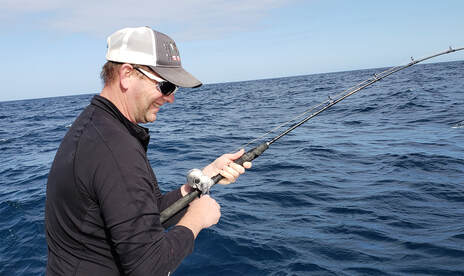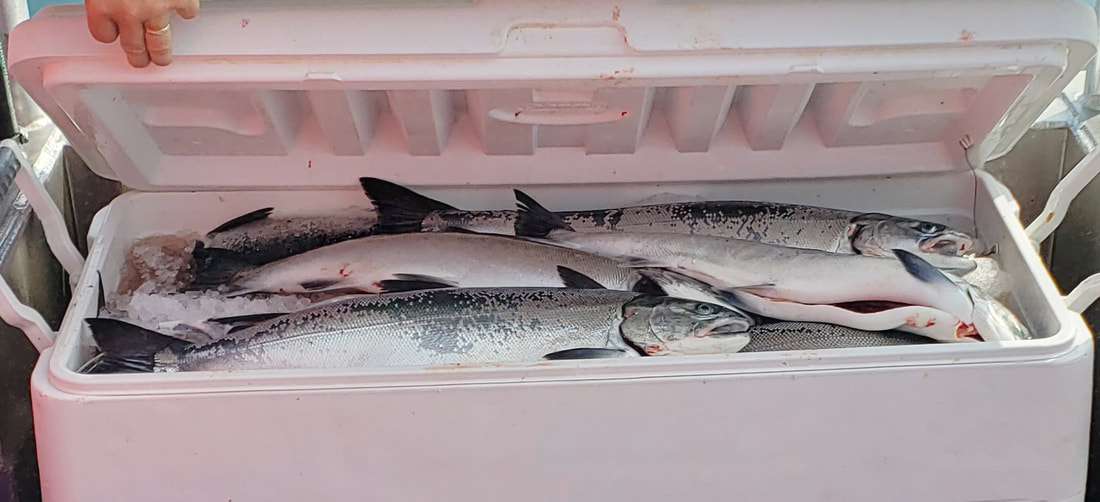
Ocean Salmon Fishing 101
Techniques and tactics for Salmon Fishing vary greatly depending on where you fish. This document is intended for Shake N Bake clients and outlines how we do it on the Shake N Bake.
How deep to fish
Coho feed near the surface, especially in the morning. You do not need to have your gear more than 15 feet deep for Coho (Silver) Salmon. Many Coho are caught in the top 7 feet of water. Chinook can be deeper, but in the morning, they will be feeding up high with the Coho. Your deckhand and Captain will provide guidance on the best depth for where your rod is positioned on the boat.
The bite
When the fish hits, you will see the rod tip bounce violently.
Sometimes Coho will hit your bait and not get hooked. You may see the rod bounce down violently once or twice and then stop. This is known as a “drive-by”. If this happens, keep alert. Leave the rod in the holder and the bait in the water for another minute or two. Coho are aggressive when they are feeding, and they will often return to the bait for a second chomp at it after missing it the first time. Sometimes pulling 2-4 feet of line quickly off the reel soon after a drive-by strike will also entice a bite as the bait will drift back toward the fish as if it has been wounded. If you have a drive-by strike and the fish does not come back to the bait within a minute or two, reel in and get a new bait.

Fighting the fish
When an Ocean salmon strikes there is generally nothing subtle about it. Your rod tip will bounce violently. If your rod has a fish on it, do not set the hook! The fish and the forward moment of the boat generally takes care of that. Instead, quickly take the rod out of the holder and begin reeling keeping a good bend in your rod and pressure on the fish.
Fight the fish with your non dominant hand above the reel. Place the butt of the rod in your abdomen at your beltline.
Do not adjust the drag setting of the reel. Your crew will set the drag at an optimal level. If you have concerns about the drag setting on your reel, ask your deckhand.
Try to keep the fish in the water by keeping the rod tip low. Lifting your rod tip above your head can cause the fish to jump and flip out of the water. Remember we are using barbless hooks and a fish jumping and flipping out of the water is more likely to throw the hook.
Keep tension on the line. Do not lower your rod tip to gain line unless you are constantly reeling.
If your line goes slack while fighting a fish, reel quickly! Coho are fast swimmers and can swim quickly towards the boat giving you the sense that you may have lost them. Reeling the slack line in quickly is the only way to tell.
When an Ocean salmon strikes there is generally nothing subtle about it. Your rod tip will bounce violently. If your rod has a fish on it, do not set the hook! The fish and the forward moment of the boat generally takes care of that. Instead, quickly take the rod out of the holder and begin reeling keeping a good bend in your rod and pressure on the fish.
Fight the fish with your non dominant hand above the reel. Place the butt of the rod in your abdomen at your beltline.
Do not adjust the drag setting of the reel. Your crew will set the drag at an optimal level. If you have concerns about the drag setting on your reel, ask your deckhand.
Try to keep the fish in the water by keeping the rod tip low. Lifting your rod tip above your head can cause the fish to jump and flip out of the water. Remember we are using barbless hooks and a fish jumping and flipping out of the water is more likely to throw the hook.
Keep tension on the line. Do not lower your rod tip to gain line unless you are constantly reeling.
If your line goes slack while fighting a fish, reel quickly! Coho are fast swimmers and can swim quickly towards the boat giving you the sense that you may have lost them. Reeling the slack line in quickly is the only way to tell.
Landing your fish
When you are bringing your fish in to be netted, your deckhand will determine whether the fish is a native (has an adipose fin) and must be released or is a hatchery fish (clipped adipose fin) and can be landed.
When Coho come off the hook, they are typically lost right at the boat so follow your deckhand’s instructions carefully as you bring your fish to the net. Do not lift the Salmon’s head out of the water. Attempt to guide the fish towards the net. The deckhand will gently scoop under the fish and lift it out of the water. Note: Salmon are unpredictable and can take off for a run after they see the net or the boat. Be prepared. The fight is not over until the fish is in the net.
When you are bringing your fish in to be netted, your deckhand will determine whether the fish is a native (has an adipose fin) and must be released or is a hatchery fish (clipped adipose fin) and can be landed.
When Coho come off the hook, they are typically lost right at the boat so follow your deckhand’s instructions carefully as you bring your fish to the net. Do not lift the Salmon’s head out of the water. Attempt to guide the fish towards the net. The deckhand will gently scoop under the fish and lift it out of the water. Note: Salmon are unpredictable and can take off for a run after they see the net or the boat. Be prepared. The fight is not over until the fish is in the net.
Once your deckhand lifts the fish into the boat, pull some line out of your reel to provide him a little slack. Do this by grabbing the line near the reel and pulling it away from the reel. 2-3 feet of slack is generally sufficient. Hold your rod with the tip straight up in the air and grab the weight so that it does not swing around. Follow your deckhand across the deck until he has removed the hook from the fish. Hooks and sinkers are notorious for getting caught up in the net especially when there is an energetic Coho flipping around in the net. Once your hook is free from the fish, reel in the slack while maintaining control of the hook and weight. Once your deckhand has taken care of the fish, he will check your leader for frays and get you baited up and fishing once again.
Barbless Hooks
Fishing with barbless hooks helps ensure that native fish survive, but it also makes losing fish a much more likely scenario. Do not get discouraged if your fish spits the hook. Keep a positive attitude, get a fresh bait and get it back in the water.
Marking your catch
Once your fish is landed, mark your fish on your license. Your deckhand can provide you with the pertinent location and species codes depending on whether your license is an Oregon License or a Washington License.
Barbless Hooks
Fishing with barbless hooks helps ensure that native fish survive, but it also makes losing fish a much more likely scenario. Do not get discouraged if your fish spits the hook. Keep a positive attitude, get a fresh bait and get it back in the water.
Marking your catch
Once your fish is landed, mark your fish on your license. Your deckhand can provide you with the pertinent location and species codes depending on whether your license is an Oregon License or a Washington License.
